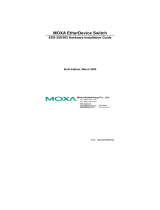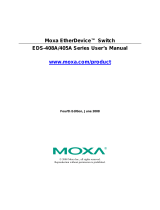
- 11 -
CPLR/TAIL GREEN
On
1. The switch’s coupling function
is enabled to form a back-up path
2. When it’s set as the Tail of the
Turbo Chain.
3. POST S.W. Fails
(+Stat on and
Fault blinking)
Blinking
1. Turbo Chain is down.
2. The switch is set as Turbo
Chain’s Member and the
corresponding chain port is down.
Off
1. This switch has disabled the
coupling function.
2. This switch is set as a Member
+MSTR/HEAD
Blinking
discovered/located by MXview (2
10M
(TP)
GREEN
TP port’s 10 Mbps link is active.
Blinking
Data is being transmitted at 10
TP Port’s 10 Mbps link is inactive.
100M
(TP)
GREEN
TP port’s 100 Mbps link is active.
Blinking
Data is being transmitted at 100
TP Port’s 100 Mbps link is inactive.
Auto MDI/MDI-X Connection
The Auto MDI/MDI-X function allows users to connect the
EDS-405A-PTP’s 10/100BaseTX ports to any kind of Ethernet device,
without needing to pay attention to the type of Ethernet cable being used
for the connection. This means that you can use either a straight-through
cable or cross-over cable to connect the EDS-405A-PTP to Ethernet
devices.
Specifications
IEEE802.3, 802.3u, 802.3x, 802.1D, 802.1Q, 802.1w,
802.1p, 802.1X, 802.1s
Protocols IGMPv1/v2, GMRP, GVRP, SNMPv1/v2c/v3, DHCP
Server/Client, DHCP Option 66/67/82, BootP, TFTP,
SNTP, SMTP, RARP, RMON, HTTP, HTTPS, Telnet, SSH,
Syslog, EtherNet/IP, Modbus/TCP, PROFINET, SNMP
Inform, LLDP, IEEE 1588 PTP V2, IPv6, NTP
MIB-II, Ethernet-Like MIB, P-BRIDGE MIB, RMON MIB
Group 1, 2, 3, 9, Bridge MIB, RSTP MIB
IEEE802.3x flow control, back pressure flow control


















